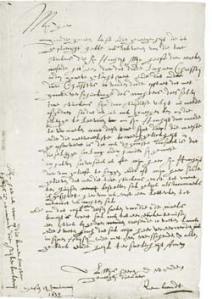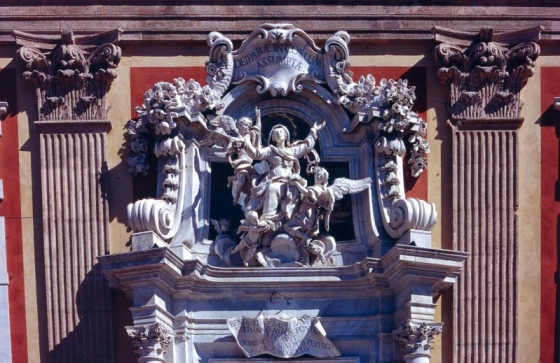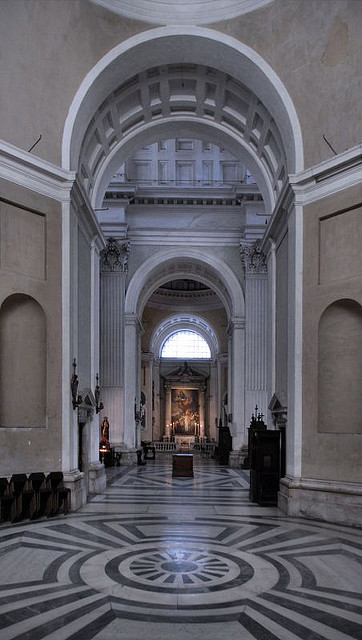Rembrandt left very few traces of his own words. A few hand-written letters to the Secretary of the Stadtholder early in his career, his testimony in some court cases, a few half-sentences quoted by former students. Wouldn’t we like to be able to follow him in the process of dealing with a client? It so happens that a few years ago correspondence concerning a hitherto unknown Italian commission has been discovered that sheds some light on this tantalising subject. A commission, moreover, that is highly unusual and adds a new chapter to the Master’s life and career.
The correspondence was accidentally discovered in the Durazzo Giustiniani archives in Genoa and concerns two modelli for altarpieces commissioned from Rembrandt. The letters and accounts are evidence that in 1666, in the twilight of his career, Rembrandt was anything but the impoverished, bankrupt painter history still seems to romantically favour. Quite the contrary: the Master was courting the Italian market as much as it was courting him. The self-assured self-portrait Rembrandt painted in these years may reflect those ambitions.
The nature of the commissioned modelli is not quite clear but they are referred to as “quadretti” (small paintings) or “dissegnio […] colorito” (drawing in colour). The subject of one is known: an Assumption of the Virgin, a highly unusual subject for a protestant painter. It is safe to assume that both were small-scale painted studies to be sent to the client for approval upon which the actual commission would be given – or not.
The modelli were commissioned by Francesco Maria Sauli, a member of one of the wealthiest and most prominent Genoese families. For the monumental family church the Saulis were building in Carignano, Genoa, the basilica of Nostra Signora Assunta, no costs were spared. The church should in every way become an everlasting testimony to the grandeur of the Sauli family, reminiscent of St. Peter’s in Rome and visible even from the sea. The French sculptor Pierre Puget was hired to decorate the interior of the church which would include a baldachino similar to Bernini’s in St. Peter’s but topped by a monumental sculpture of the Assumption of the Virgin. For some reason, this scheme was abandoned and in its place a high altar that would be crowned with Rembrandt’s Assumption was envisaged.
It would have been more practical if Sauli had turned to Italian painters for this all important painting for they would have understood the catholic Marian symbolism of an Assumption. Perhaps Sauli’s close commercial ties with the Low Countries meant that he was well acquainted with the Dutch art market and Rembrandt’s work. In addition, some etchings by Giovanni Benedetto Castiglione in his collection that were heavily indebted to Rembrandt may have made him look to the Dutch painter for the crowning masterpiece of his church.
The recently discovered correspondence takes place between Francesco Maria Sauli, sea captain Viviano and two of Sauli’s business agents in Amsterdam, Voet and Benzi. It starts on 19 June 1666 when Voet and Benzi, having introduced captain Viviano to the painter the day before, visit Rembrandt in his modest house on Rozengracht and report to Sauli:
[Rembrandt] has promised to make two models [modelli] of the paintings you want so that they can be sent [to Genoa] at the end of the month. He wants a lot of money, but he presents himself as someone who has knowledge of the art of painting and therefore he stands his ground.
Sauli replies on 17 July:
I find this very satisfactory. With regard to the amount he is asking: he will have to be satisfied with what is reasonable, and we for our part will not deviate from what is customary and from what the work is worth. He will have to explain exactly what he wants when he delivers the models or designs, and then it will be up to us to respond.
But the agents soon discover that they are dealing with an artist who follows his own timetable and that inspiration nor execution can be rushed. After more visits and empty promises from Rembrandt, the modelli are still not finished and Voet and Benzi, far more customary with straightforward commercial deals, write to Sauli on 17 September in a somewhat exasperated tone: “as is usual among painters, this man is rather excentric and one cannot rely on what he says.”

The negotiations took place in Rembrandt’s small rented house on Rozengracht. This photo of 1867 shows Rozengracht before the canal was filled in and Rembrandt’s house was demolished (Stadsarchief Amsterdam)
Rembrandt does apologise in some fashion for the delay:
Although he has already thrown himself into the work heart and soul, he cannot finish it within the time required.
Where have we heard this before? On 12 January 1639 Rembrandt had written in the same vein to Constantijn Huygens, secretary to the Stadtholder, who had commissioned a Passion Series from him, at the same time adding the four words (“the most natural movement”) that have puzzled art historians ever since: “… in these two the greatest and the most natural movement is observed which is also the reason that I have had them so long in my hands.” In both cases Rembrandt would have been aware of the importance of the commissions. The Stadtholder’s Passion Series could mean possible future court commissions; likewise, Sauli’s commision might bring future aristocratic Italian commissions should he succeed: “He says that he wants to gain praise and honour in our parts with this commission,” report Voet and Benzi. At 60, Rembrandt was by no means any less ambitious than he had been in his younger years. If the Dutch market was no longer interested – changing tastes made that his lucrative portrait commissions had all but dried up and the English sea wars made the times insecure and clients reluctant to spend – he was seeking clientele elsewhere.
On 3 December, an increasingly frustrated Captain Viviano reports:
I am at a loss how to come to an agreement with Rembrandt: he is now asking me for 3000 guilders for both, whereas he initially asked for only 1200 guilders. He is an unpredictable man but that doesn’t surprise me at all, because he is a painter and by nature they do not keep their word.
Viviano has every reason to be worried: in the 17th century, the “little ice age” (LIA) made winters in the Low Countries exceptionally harsh. Sauli drily notes on 8 January 1667: “On the matter of Captain Viviano […] we have learned that he is held hostage by the ice, so that the earliest that he will be able to leave Amsterdam is the end of February.” And so Rembrandt gets another, no doubt welcome, reprieve while Viviano is forced to spend the winter in Amsterdam. Sauli further writes to Viviano that he is prepared to pay no more than 500 guilders for the modelli.

Rembrandt, drawing currently attributed to Willem Drost with later inscription, Rembrandt House Museum
On 11 February, eight months after the commission had been given, a relieved Voet and Benzi are able to tell Sauli:
These two models from the Painter Rembrandt are finally ready and after much talk and effort the price has been established at 325 [ducats] or 1023.15 guilders […] the ice that was so thick will now melt away every day so that navigation will be possible.
Incredibly, Rembrandt had managed to more than double the fee Sauli was prepared to pay. The correspondence proper ends here but there is a tantalising payment in the Sauli accounts for 1667:
I make payment of 1049.3 guilders to Captain Gio Lorenzo Viviano for the costs incurred for two paintings that the said Captain Gio Lorenzo, on your instructions, had commissioned in Amsterdam from the painter Rembrandt and which he loaded onto his ship in that city, after which he departed for Genoa, where they will serve to decorate [illegible] in the aforementioned church.
There follows a breakdown:
- 1023.15 guilders for the paintings
- 12 guilders for two frames
- 4 guilders for a crate
- 8.10 guilders customs duty
- 18 guilders transportation [from Rembrandt’s house] to the ship.
On 28 June 1667, one year after the modelli were commissioned, the Carignano church accounts mention 2142.18 lira “for 2 paintings by the Flemish painter Rembrandt.”
Sauli’s accounts prove that the modelli were painted, framed, crated and on the ship bound for Genoa but when the ship set sail is not known. The church accounts seem to indicate that they arrived, unless the accounts refer to the full-scale altarpieces, but this seems unlikely.
On 2 December 1667, Voet and Benzi report to Sauli that Captain Viviano’s ship was shipwrecked off the English coast, but this was almost a year after Rembrandt finished the modelli. And that, for now, ends this story in as far as the contemporary records are concerned.
No evidence has been discovered yet to indicate what Francesco Maria Sauli, after all the trouble he went through to get the modelli to Genoa, thought of them – if he ever saw them. He could have concluded that the protestant painter had not understood his brief or his grand scheme for his church. They may eventually have been destroyed, or may have been lost. Perhaps they languish in a private collection somewhere, undiscovered.
Not to know Rembrandt’s vision for his Assumption is a great loss as these were the years of intensely sensitive and deeply spiritual paintings such as the Jewish Bride and The Return of the Prodigal Son. We can only dream of what a catholic altarpiece by the greatest Northern Master of the 17th century would have looked like in an Italian grand theatrical Baroque setting.
Note:
The correspondence quoted appeared in the Kroniek van het Rembrandthuis, 2007; Lauro Magnani: “1666. Een onbekende opdracht uit Genua voor Rembrandt” pp 3-18.







